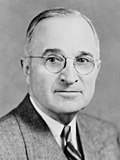| |||||||||||||||||||||||||||||||||
| |||||||||||||||||||||||||||||||||
 County results
| |||||||||||||||||||||||||||||||||
| |||||||||||||||||||||||||||||||||
| Elections in Tennessee |
|---|
 |
|
|
The 1948 United States presidential election in Tennessee took place on November 2, 1948, as part of the 1948 United States presidential election. Tennessee voters chose 12[2] representatives, or electors, to the Electoral College, who voted for president and vice president.
For over a century after the Civil War, Tennessee was divided according to political loyalties established in that war. Unionist regions covering almost all of East Tennessee, Kentucky Pennyroyal-allied Macon County, and the five Western Highland Rim counties of Carroll, Henderson, McNairy, Hardin and Wayne[3] voted Republican — generally by landslide margins — as they saw the Democratic Party as the "war party" who had forced them into a war they did not wish to fight.[4] Contrariwise, the rest of Middle and West Tennessee who had supported and driven the state's secession was equally fiercely Democratic as it associated the Republicans with Reconstruction.[5] After the disfranchisement of the state's African-American population by a poll tax was largely complete in the 1890s,[6] the Democratic Party was certain of winning statewide elections if united,[7] although unlike the Deep South Republicans would almost always gain thirty to forty percent of the statewide vote from mountain and Highland Rim support.
Between 1896 and 1948, the Republicans would win statewide contests three times but only in the second did they receive down-ballot coattails by winning three congressional seats in addition to the rock-ribbed GOP First and Second Districts.[8] In the early 1910s, prohibitionist “Independent Democrats” fled the party and formed a coalition, known as the “Fusionists,” with Republicans to elect Ben W. Hooper Governor,[9] whilst in 1920 the national anti-Wilson and anti-League of Nations tide allowed the GOP to carry a few traditionally Democratic areas in Middle Tennessee and with them the state,[10] and in 1928 anti-Catholicism against Democratic nominee Al Smith gave this powerfully fundamentalist state to Herbert Hoover.[11]
After the beginning of the Great Depression, however, for the next third of a century Republicans would rarely contest statewide offices seriously, despite continuing dominance of East Tennessee and half a dozen Unionist counties in the middle and west of the state.[12] State politics during the 1930s and 1940s was dominated by Edward Hull “Boss” Crump, whose Memphis political machine would consistently provide decisive votes in statewide Democratic primaries aided by cross-party voting by Republicans in eastern mountain counties.[12] Although Tennessee's delegates at the 1948 Democratic National Convention were all opposed to incumbent President Harry S. Truman after his proposal for black civil rights titled To Secure These Rights, the presence of potentially formidable Republican opposition in East Tennessee and the Highland Rim meant that Crump could not even keep his own machine in line.[13] Governor McCord and even Crump's long-time ally Senator Kenneth D. McKellar both broke with him over supporting States Rights Democratic nominees Strom Thurmond and Fielding L. Wright, with McCord losing the Democratic nomination to Crump foe Gordon Browning.[14] In order to get their electors on the ballot the Dixiecrats had to form a separate state organisation in Somerville,[13] although three of the Dixiecrat electors were simultaneously on the slate for Truman and Kentucky Senator Alben W. Barkley.[15] 14% of white voters supported Thurmond.[16]
- ^ "United States Presidential election of 1948 — Encyclopædia Britannica". Retrieved October 31, 2017.
- ^ "1948 Election for the Forty-First Term (1949-53)". Retrieved October 31, 2017.
- ^ Wright, John K. (October 1932). "Voting Habits in the United States: A Note on Two Maps". Geographical Review. 22 (4): 666–672. Bibcode:1932GeoRv..22..666W. doi:10.2307/208821. JSTOR 208821.
- ^ Key (Jr.), Valdimer Orlando; Southern Politics in State and Nation (New York, 1949), pp. 282-283
- ^ Lyons, William; Scheb (II), John M.; Stair, Billy (2001). Government and Politics in Tennessee. Univ. of Tennessee Press. pp. 183–184. ISBN 1572331410.
- ^ Phillips, Kevin P.; The Emerging Republican Majority, pp. 208, 210 ISBN 9780691163246
- ^ Grantham, Dewey W. (Fall 1995). "Tennessee and Twentieth-Century American Politics'". Tennessee Historical Quarterly. 54 (3): 210–229.
- ^ Phillips; The Emerging Republican Majority, p. 287
- ^ Langsdon, Phillip (2000). Tennessee: A Political History. Franklin, Tennessee: Hillsboro Press. pp. 287–295.
- ^ Reichard, Gary W. (February 1970). "The Aberration of 1920: An Analysis of Harding's Victory in Tennessee". The Journal of Southern History. 36 (1): 33–49. doi:10.2307/2206601. JSTOR 2206601.
- ^ Larson, Edward J. (October 3, 2006). Summer for the Gods: The Scopes Trial and America's Continuing Debate over Science and Religion. Basic Books. ISBN 9780465075102.
- ^ a b Majors, William R. (1986). Change and continuity: Tennessee politics since the Civil War. Mercer University Press. p. 72. ISBN 9780865542099.
- ^ a b Guthrie, Paul Daniel (1955). The Dixiecrat Movement of 1948 (Thesis). Bowling Green State University. pp. 181–182. Docket 144207.
- ^ Langsdon, Phillip Royal (2000). Tennessee: A Political History. Franklin, Tennessee: Hillsboro Press. pp. 336–343. ISBN 9781577361251.
- ^ Guthrie; The Dixiecrat Movement of 1948 (Thesis). pp. 211-212
- ^ Black & Black 1992, p. 147.


